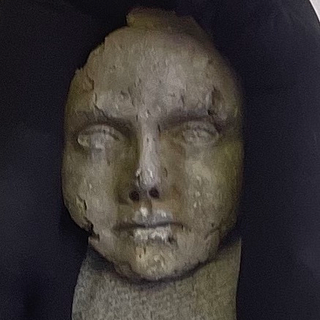Nan Martin solo show
Collin College, Spring Creek Campus
Plano, Texas
Feb. 26-March 20, 2024
To move through Nan Martin’s studio, you almost have to dance. The sculptures composed on the wall space have faces that glance here and there, feet that dangle and kick out into space. Some sculptures are colorful, with soft shapes and pivot around, suspended from the ceiling. Other sculptures, of cement and wire, look both heavy and hollow at the same time.
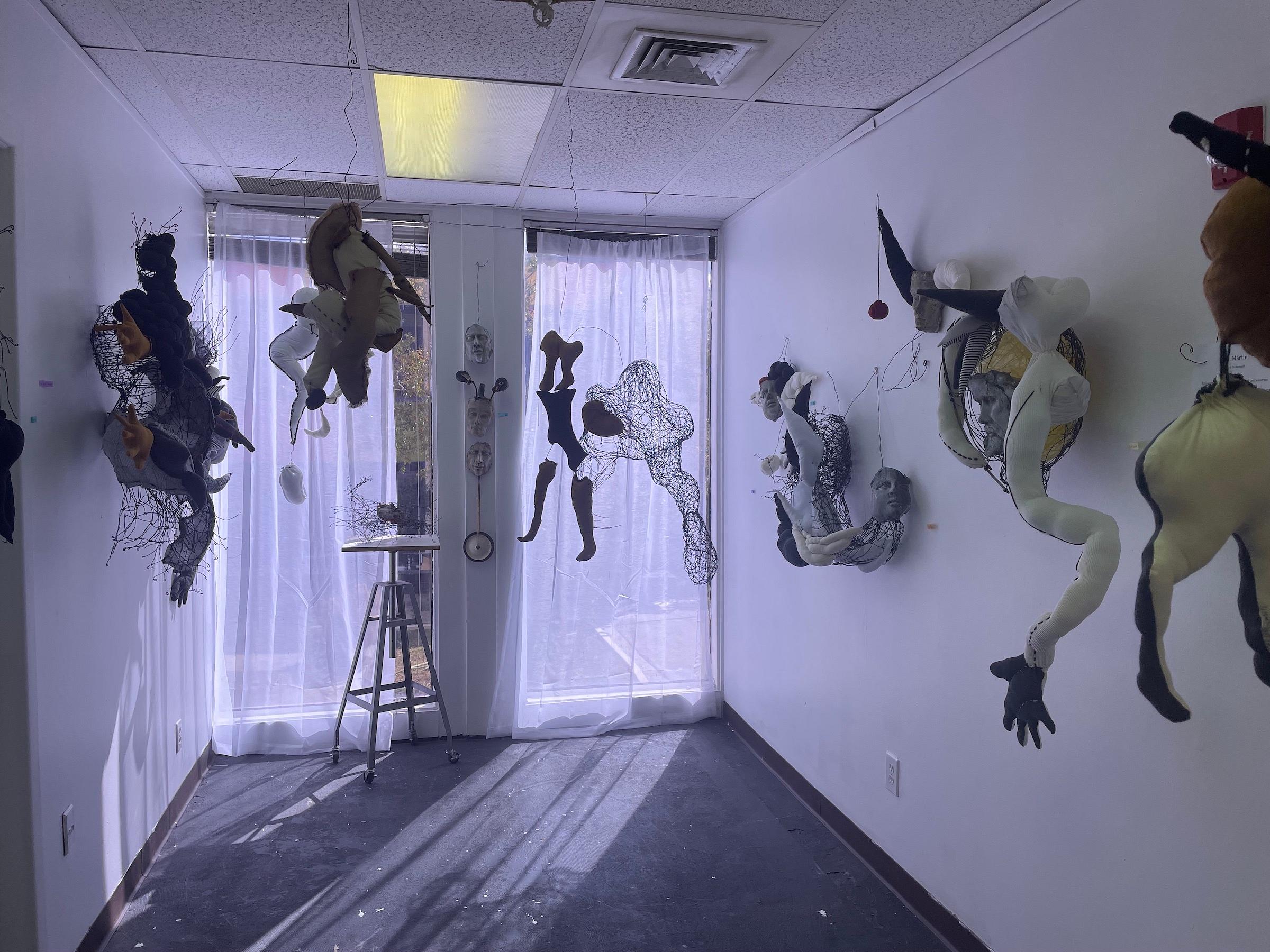
I am here reviewing Martin’s work and speaking with the artist in advance of a public solo exhibition that opens in February.
Martin’s process is spontaneous. She begins each sculpture not knowing where the shapes will take her. She lays out strands of wire and begins bending and twisting them together. “The wire pieces I just make. I don’t have a plan or sketch. I see the wire pieces as the sketch. Drawing in space. And the nice thing about wire is you can just bend it. You can just start outlining it and adding and adding and adding, and then for me I get this intuition, I see what’s it’s going to be once I get started with it. And playing and feeling the wire and twisting it,” Martin says.
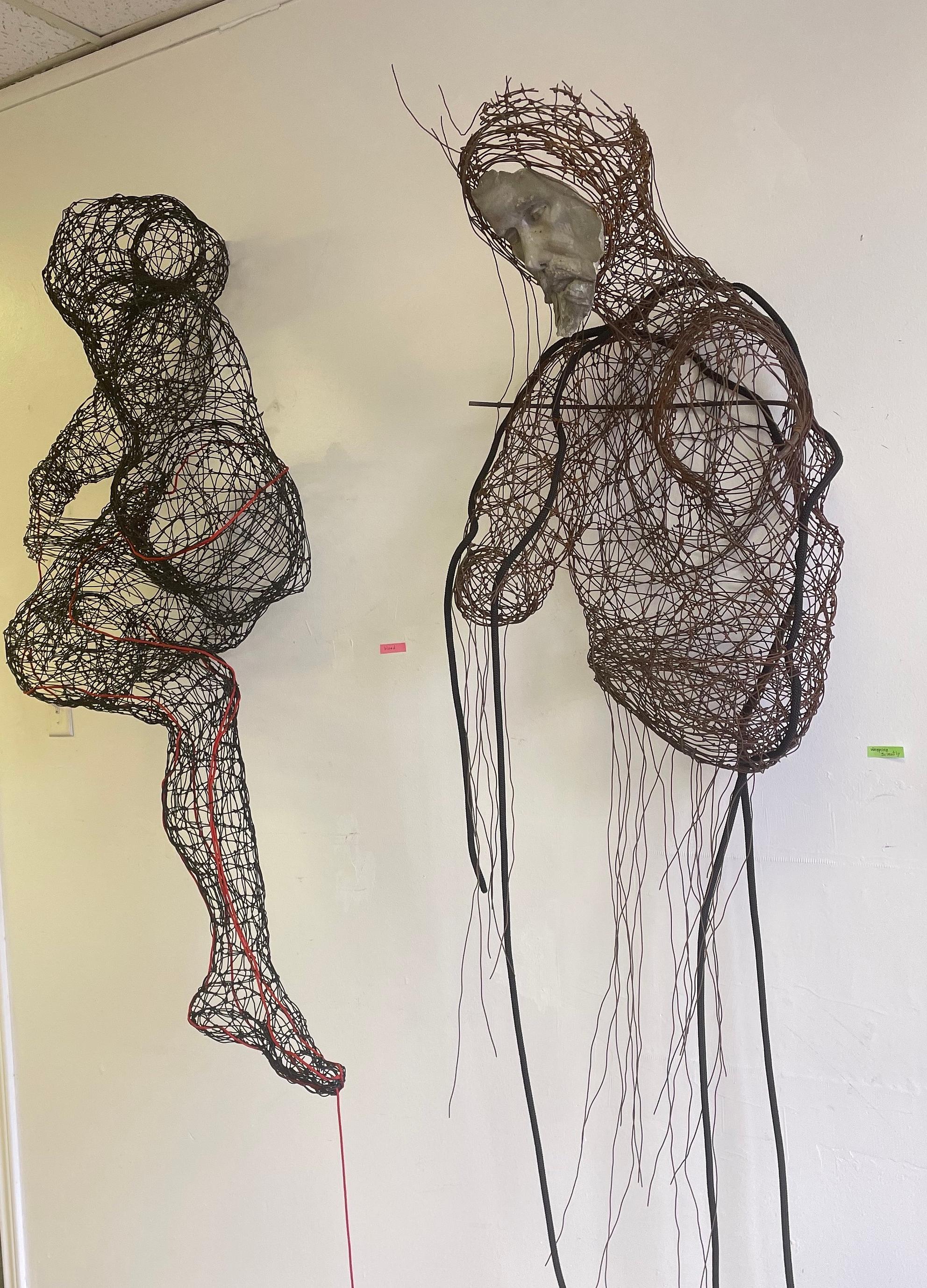
Martin’s early works in wire, cement and metal are hard, dark and somber. The cement faces are made through a laborious process of first sculpting faces in clay and firing the faces to be ceramic. Martin then creates silicon molds and fills them with cement to create her sculptures’ faces. The end result is that the cement has a both a smooth surface, but also can appear to fall away or be crumbling in part, lingering in the past. Her knowledge of materials is a result of her time spent working directly with them.
Her use of line and anatomy are fascinating, the dark wire funnels, and moves the eye along down to the suggestion of a human foot. Feet are thematic throughout the work. For her the feet suggest a choice. Martin is clear about the imagery of feet and choices made in life, “Which path are you going to take, physically of course, but symbolically, we don’t know, especially when we are young, we don’t’ know how this path is going to take us.”
The wire sculptures are hung and they appear to be alive because the wire creates a changing optic as you move around them and view them at different angles. The suspended works have joint angels, legs and feet that could be read as lifeless, but because the sculptures are hung and swing in the air, they have a ghostly kind of life-like feel to them. The feet of the sculptures do look as if they are headed off in a direction down an invisible path.
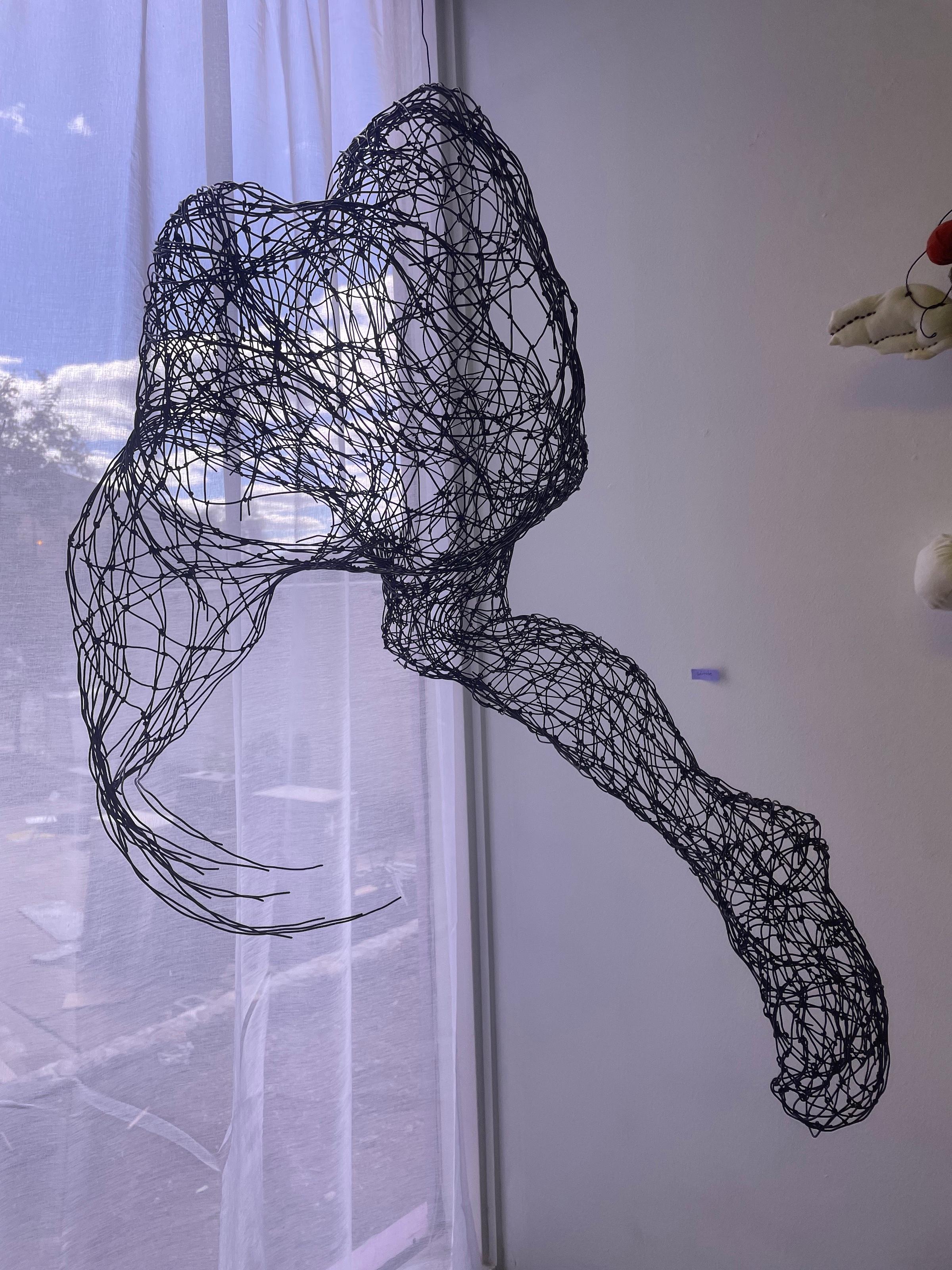
“I’ve made some bad decisions, taken some bad paths and my feet have taken me. So, your feet take you to these places. It’s a symbol of the choices you have made, can make, and it’s beautiful.” While Martin describes the unknown destinations our feet can take us, she also plays with the freedom and levity that feet can give us. “I love going to the ballet and watching them dance. Their feet. The beautiful lines of the ballet dancer and again.”
Martin speaks of feeling directionless herself before she began this body of work. She and her husband had moved to McKinney and were reeling from grief and loss. Her husband encouraged her to take art classes at a nearby community college. It was in a sculpture class that an instructor handed the students a roll of wire and told them to do something with it. She was fascinated by the wire as being a line in space, like that of a line on paper, but more immediate. She lays out strips of wire on her studio floor and begins sketching out the shapes, twisting the wire and responding to the material an immediate way.
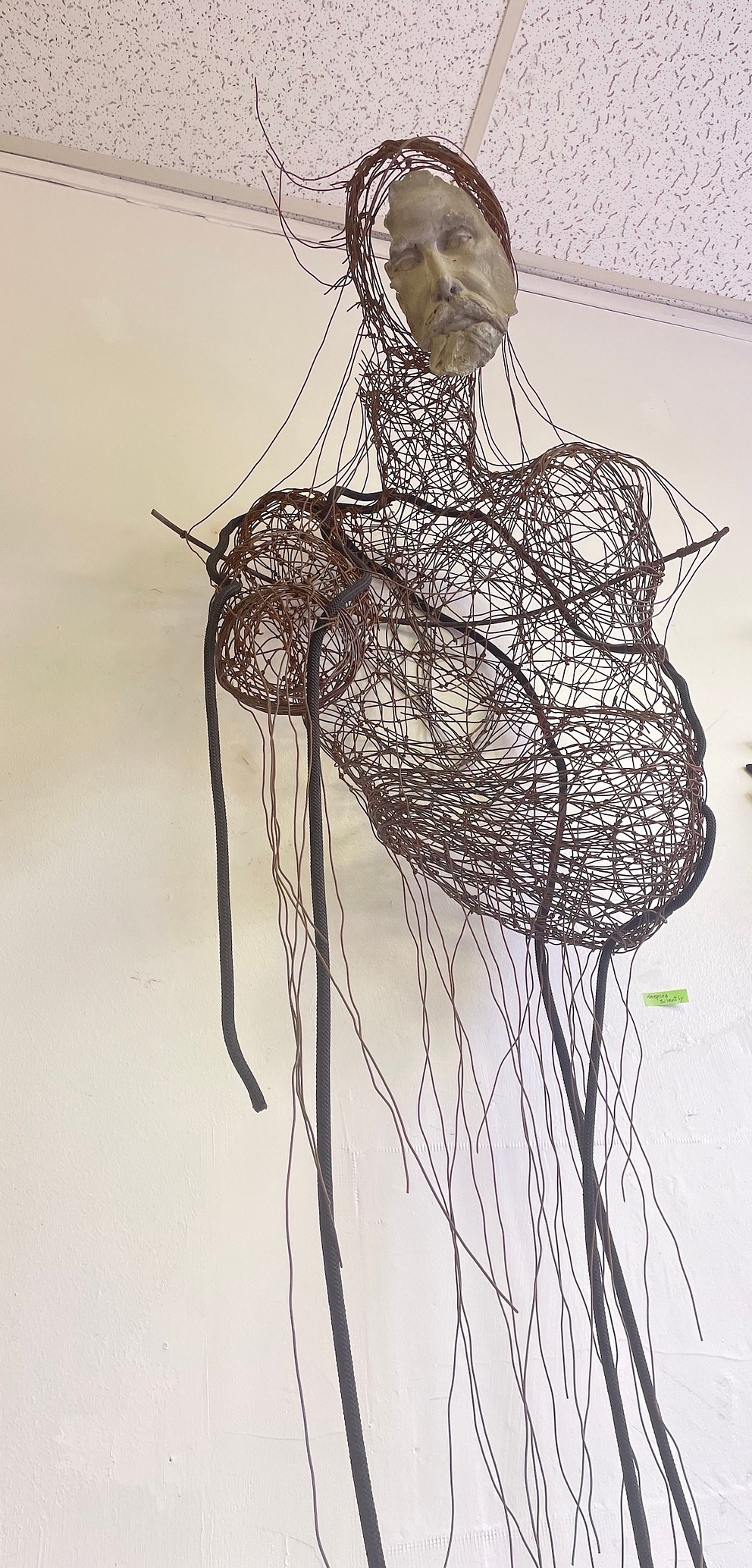
Her work often incorporates welding and metal work as well. She speaks to needing to use hard processes and hard materials to convey the hardships of life. “Life does get difficult, but then this year, I decided to go back with textiles. I found myself I love doing laundry at home, and folding the fabric, ‘this is my favorite job around the house,’ so I tried to incorporate textiles with my wire. I didn’t know how to do that at first. I started making fabric balls, and now I am just pretty much incorporating some cement with the wire and textiles. I am at this time in my life when I want to have fun. And this is great fun.”
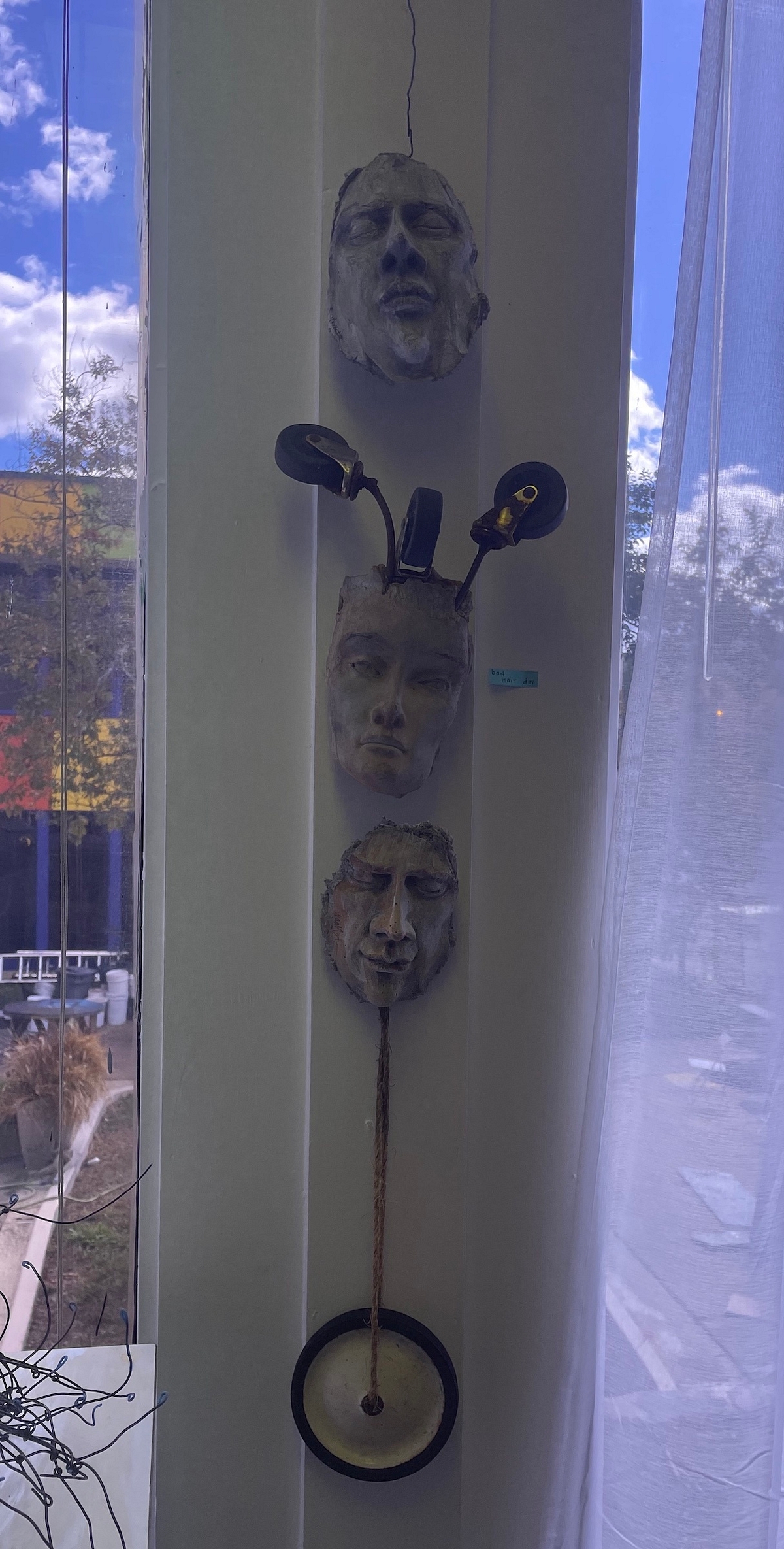
Her work began in a dark place as a result of loss and pain. Now, she is decidedly moving her work toward the direction of play, joy and comfort. She’s doing this by returning to her prior training in textiles and building on to her hard material sculptures by incorporating fabrics with stripes, polka dots, and a specific color palate of white, black, sienna, and charcoal. She has also begun to paint on the fabric shapes. Her details in stitching, shapes, and addition of buttons, etc. have transformed the work into living characters, and moved it away from the hard, dark and sharp wire forms. Her visual arts training is clear, and her overall vision is clean and expert.
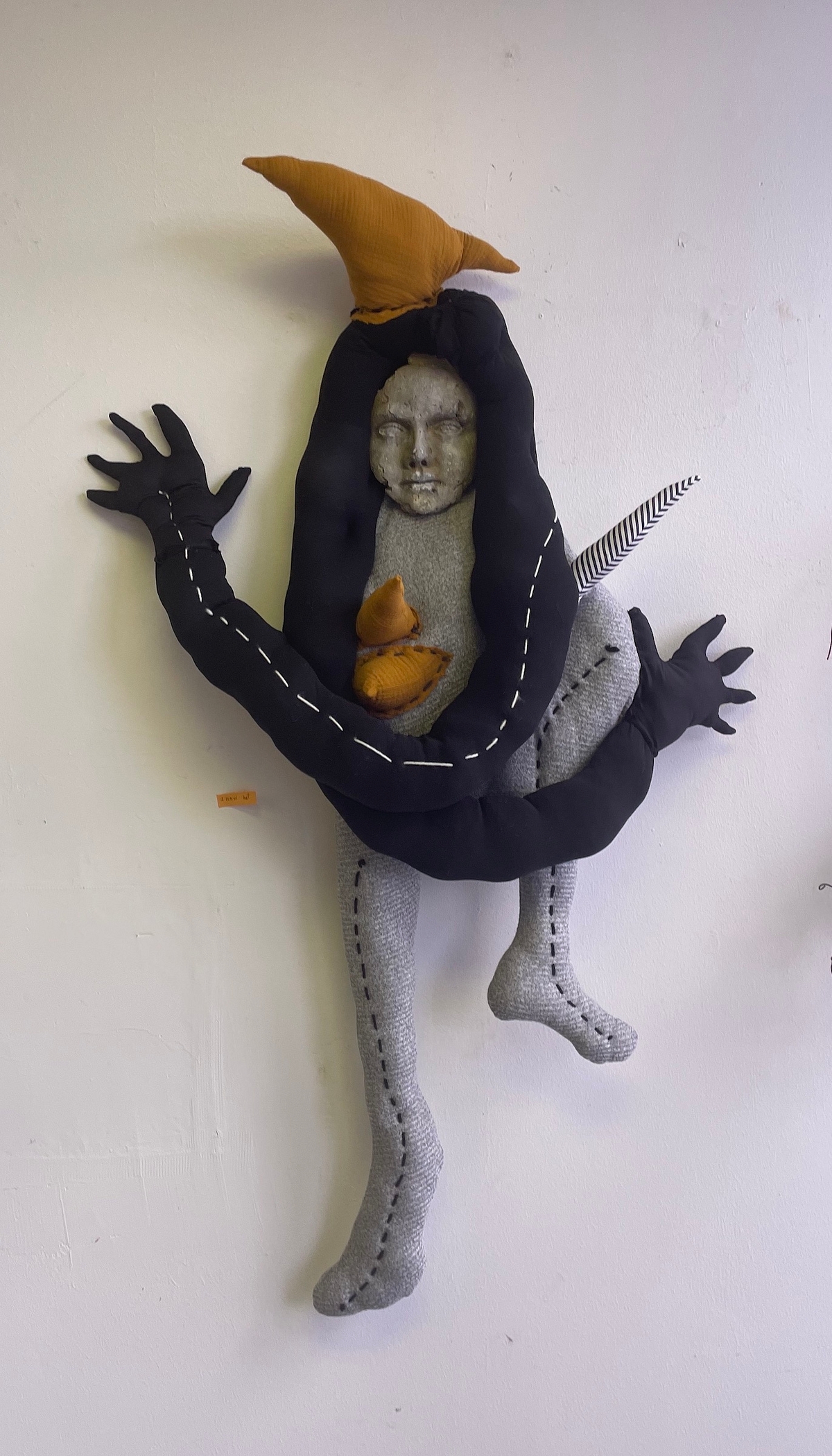
As she speaks of life imitating art and art imitating life, I cannot help but notice that she is wearing the colors of her characters. While this may seem innocent enough, it also speaks to a deeper tradition in making, one of Folk Art, the artistic tradition of everyday people taking objects in their lives and transforming them into other objects or decorations. It is largely undervalued because it is taken for granted. It is arguably the backbone of culture and making.
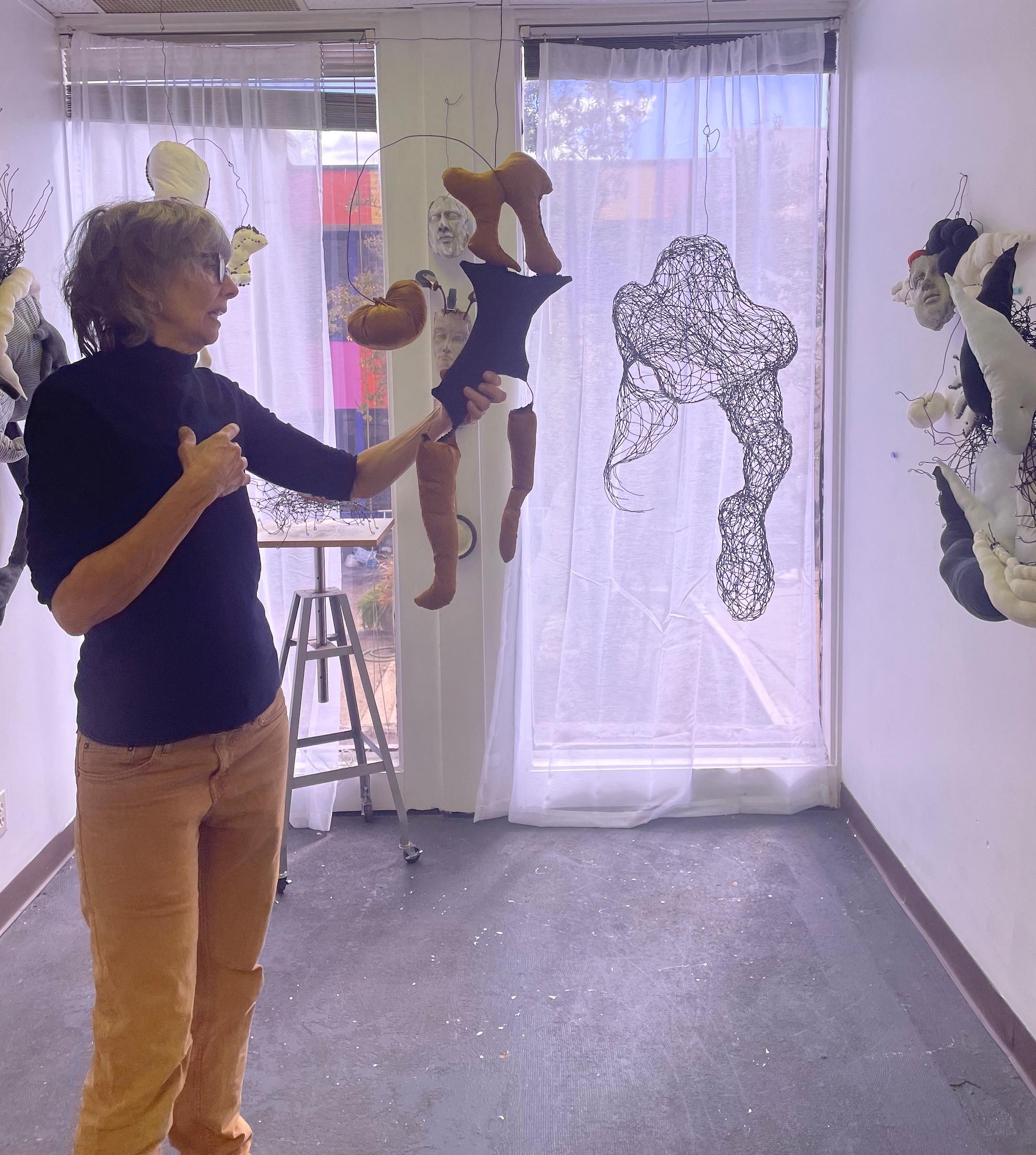
Martin can point around her studio and tell you the past of the fabrics or pieces she’s used. “The body of that piece that was a dress my mom gave me years ago, a I didn’t like the dress, so I made it into a skirt and I didn’t like the skirt. It means something to me, because it was from my mom and I wore it, I just try to create snatches of my feelings my experience. I think that’s what most creative people do, whether they write, make film or dance. We put our personal experiences into our art from.”
Her personal story is hidden in the sculptures and materials, and she speaks to wanting to allow the viewers to experience them and draw their own conclusions. “I want my work to be again just be seen and start a conversation about art and about who we are as humans how we share so much as humans. The suffering the joy, the sorrows. And just to have that conversation and I think that makes you plunge a little deeper inside of you, maybe make some connections with the experiences you’ve had. That’s what this is all about for me.” States Martin.
Martin’s work is crossing over into a fine art realm, and is an example of an artist working between two artistic traditions: folk art and fine art. Curators and museums like it when an artist is clearly working in one or the other. It’s easier to speak about the artistic body if it falls neatly into one, single category. However, artists who can craft work in both are doing interesting, experimental things. Professional art experts can argue until they turn blue on whether such objects belong in a museum or not, but the truth is, objects that are both art and craft embody culture and innovation.

Many artists will tell you this, that they thrive on learning how their work is seen and experienced by others. It helps the artists step out of their limited perspective and be able to gain the critical perspective needed to advance their ideas. Martin’s work falls into a thematic place that has often been overlooked and, at times, rejected by traditional art critics.
“All of our experiences have long-term effects, some more than others. And I do think love is profound. And it’s taken lightly, and what is love. It’s different for everybody. But I think the profound idea for a creator a sculptor or artists to make a profound art that that’s profundity is in the eye of the beholder. So, if you make something that has some deep meaning, politically or ecology some other topic, to make a real statement that is impactful,” says Martin.
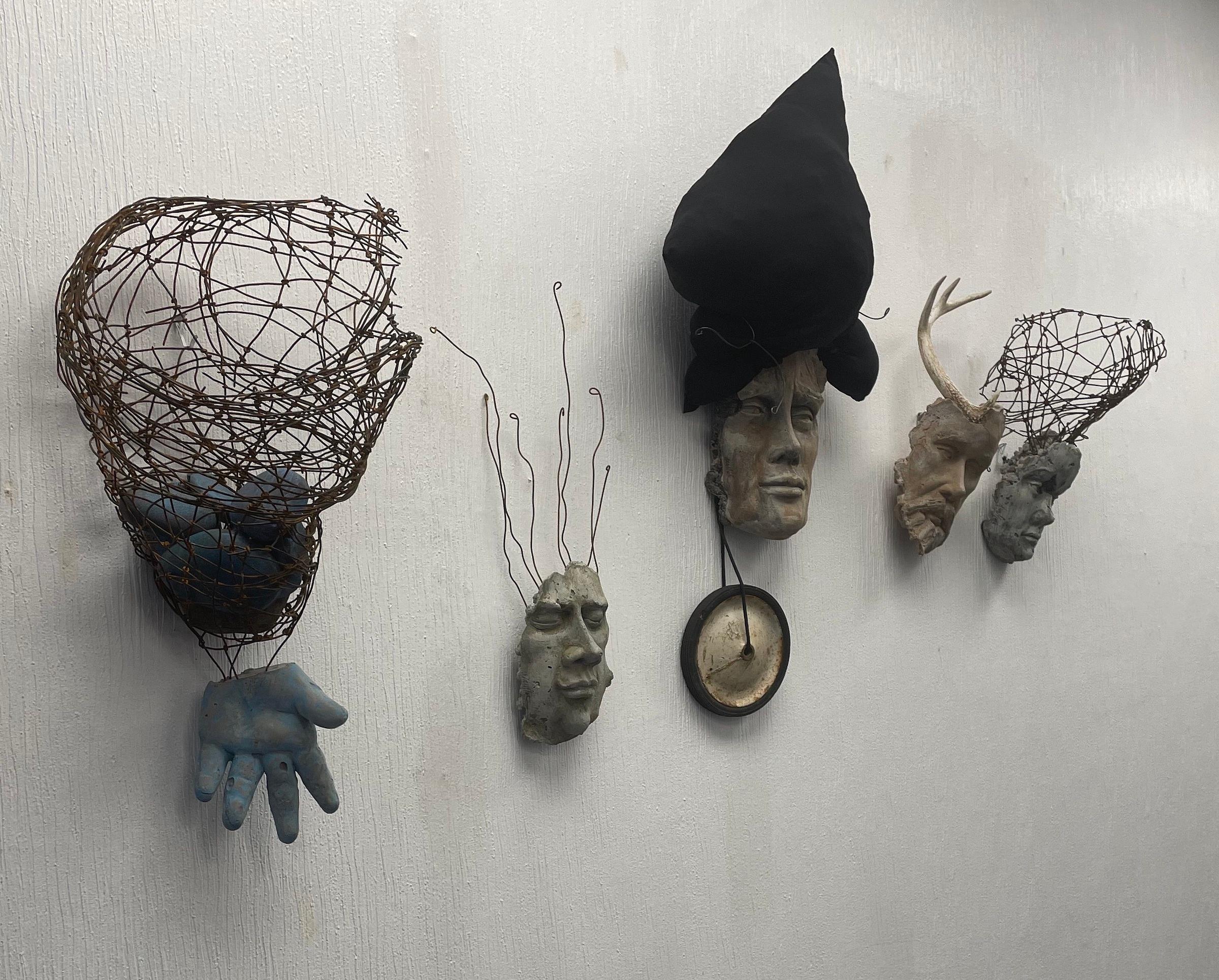
Martin talks of how she has attempted to work with political topics, and even of how she has struggled with the idea of selling her work or making objects that she thinks may appeal to buyers. Ultimately, she’s decided it’s not a place of authenticity for her making process. She has turned to embrace a conceptual area that is profound in the nature of humanity.
“After a while, [I decided] it’s about love. And making human connections and making people feel good. But being authentic and that’s hard to find your authentic self. Isn’t that hard to find? I had struggled with that. I had great insecurity and I am sure everybody does to some degree. But I think this helps work through insecurity and self-doubt,” she says.
Martin speaks of her childhood best friend, a stuffed animal, and that connection to comfort she had. The stuffed animal or blanket is called a “transitional object” in psychology. It serves the child to have comfort and security during early childhood when parents begin to ween children from clinging and encourage children to become independent. These everyday objects (dad’s old shirt, a crocheted blanket) given to children become a tool for emotional growth and a way for them to maintain well-being while learning how to become independent.
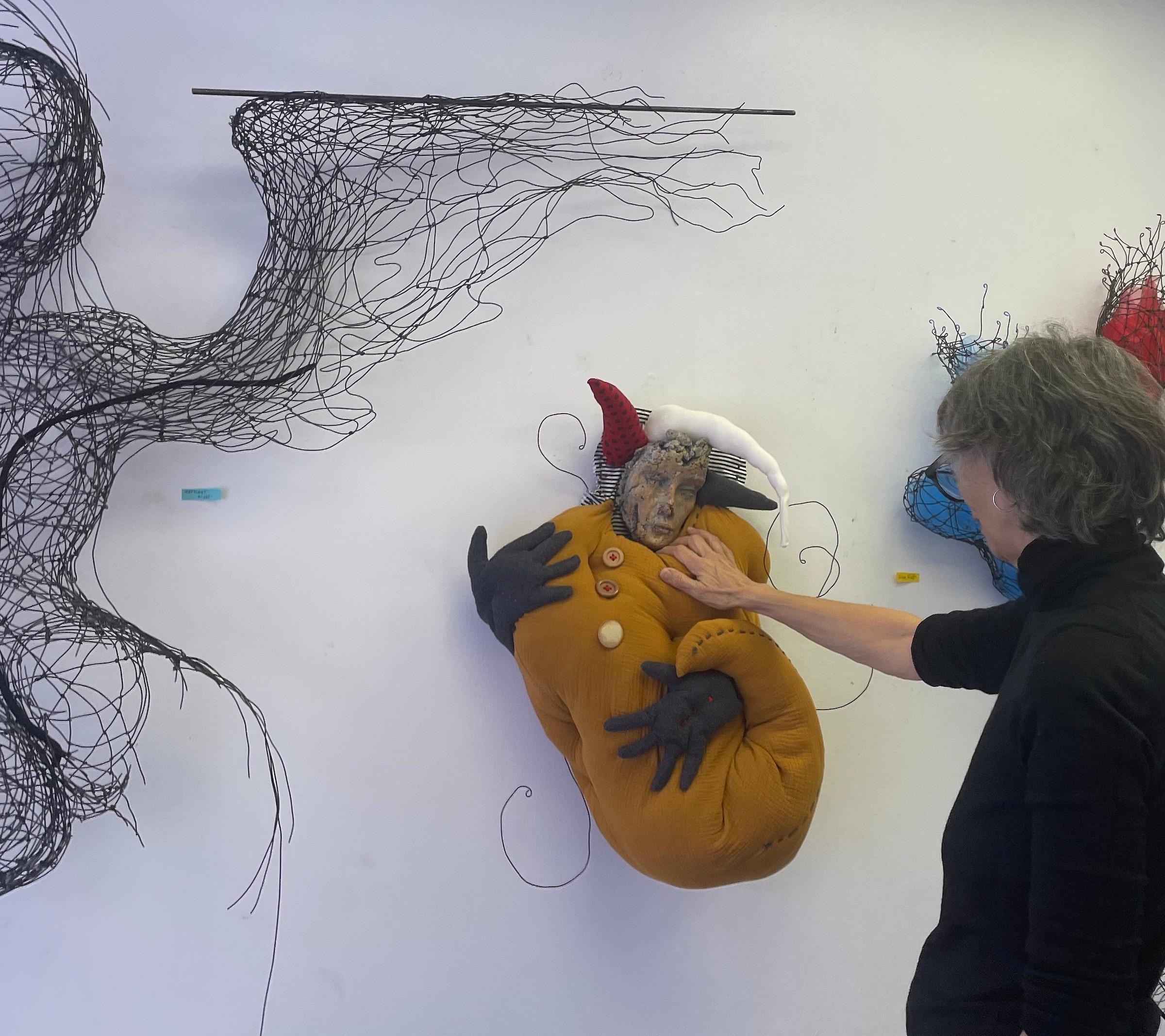
“Some people you have to be profound, you have to make a profound statement. with whatever it is you’re making that I think back, when I was a child, my best friend was Zippy, my stuffed animal monkey. That was my best friend. To be able to hold him. And I think we all need hugs and that’s not a real profound, is that a profound experience? Love. Loving someone. That to me is profound. And I think this is wat I want these pieces to kind of evoke that. A sense of comfort. that these pieces can offer comfort,” Martin states.
You can also find more about Nan Martin her work and story here.
